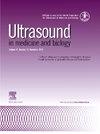Delivering Gd-Labeled IgG Antibodies Into the Mouse Brain Following Focused Ultrasound Treatment
IF 2.4
3区 医学
Q2 ACOUSTICS
引用次数: 0
Abstract
Objective
Antibody-based therapy has emerged as a powerful tool for targeted treatment of neurological diseases, such as brain cancer and neurodegenerative disorders. However, direct, scalable, and safe confirmation of antibody delivery into the brain remains challenging. Antibodies can be effectively tracked when tagged with molecules that are detectable by medical imaging modalities, such as MRI, PET, or SPECT. In this study, we aimed to confirm gadolinium (Gd)-labeled IgG antibody delivery into the mouse brain using MRI, following exposure to focused ultrasound (FUS) and circulating microbubbles.
Methods
We acquired MR images of the mouse brain to evaluate antibody delivery into the targeted brain region. First, we quantified the MR signal of Gd-labeled IgG antibodies in phantoms using preclinical 9.4 T and clinical 3 T MRI scanners. Then, we determined optimal ultrasound and MR imaging parameters to non-invasively and safely disrupt the blood-brain barrier in a localized and reversible manner and effectively monitor antibody delivery into the murine brain, respectively.
Results
We confirmed that IgG antibodies can be reliably delivered into the murine brain using FUS and microbubble treatment and that we can track their biodistribution within the brain parenchyma using clinically relevant MR image sequences. The maximum detected volume of Gd-IgG antibody delivery (n = 4) was determined to be 0.12 ± 0.02 mm3 at t = 75.3 ± 17.3 minutes following treatment.
Conclusion
This work paves the way for a scalable and non-ionizing method for performing and evaluating antibody delivery into the brain.
聚焦超声治疗后将gd标记的IgG抗体送入小鼠大脑。
目的:基于抗体的治疗已经成为靶向治疗神经系统疾病的有力工具,如脑癌和神经退行性疾病。然而,直接、可扩展和安全地确认抗体进入大脑仍然具有挑战性。当用分子标记抗体时,抗体可以被有效地跟踪,这些分子可以被医学成像模式检测到,如MRI、PET或SPECT。在这项研究中,我们旨在通过MRI确认钆(Gd)标记的IgG抗体在聚焦超声(FUS)和循环微泡暴露后进入小鼠大脑。方法:我们获得了小鼠大脑的MR图像来评估抗体进入目标大脑区域的情况。首先,我们使用临床前9.4 T和临床3 T MRI扫描仪量化了幻影中gd标记的IgG抗体的MR信号。然后,我们确定了最佳的超声和磁共振成像参数,以非侵入性和安全地局部可逆地破坏血脑屏障,并有效地监测抗体进入小鼠大脑的情况。结果:我们证实IgG抗体可以通过FUS和微泡治疗可靠地传递到小鼠脑内,并且我们可以通过临床相关的MR图像序列跟踪其在脑实质内的生物分布。治疗后t = 75.3±17.3 min,检测到的Gd-IgG抗体最大递送量(n = 4)为0.12±0.02 mm3。结论:这项工作为一种可扩展和非电离的方法铺平了道路,用于执行和评估抗体进入大脑。
本文章由计算机程序翻译,如有差异,请以英文原文为准。
求助全文
约1分钟内获得全文
求助全文
来源期刊
CiteScore
6.20
自引率
6.90%
发文量
325
审稿时长
70 days
期刊介绍:
Ultrasound in Medicine and Biology is the official journal of the World Federation for Ultrasound in Medicine and Biology. The journal publishes original contributions that demonstrate a novel application of an existing ultrasound technology in clinical diagnostic, interventional and therapeutic applications, new and improved clinical techniques, the physics, engineering and technology of ultrasound in medicine and biology, and the interactions between ultrasound and biological systems, including bioeffects. Papers that simply utilize standard diagnostic ultrasound as a measuring tool will be considered out of scope. Extended critical reviews of subjects of contemporary interest in the field are also published, in addition to occasional editorial articles, clinical and technical notes, book reviews, letters to the editor and a calendar of forthcoming meetings. It is the aim of the journal fully to meet the information and publication requirements of the clinicians, scientists, engineers and other professionals who constitute the biomedical ultrasonic community.

 求助内容:
求助内容: 应助结果提醒方式:
应助结果提醒方式:


